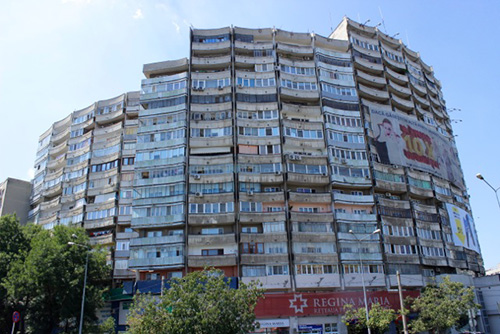After 1947, Romania’s Soviet-imposed and Soviet-backed communist government embarked on a thorough transformation of the country’s economy and, through it, of social relations. After industry and agriculture were speedily and implacably brought under state control, the construction of housing progressively became a third crucial target of centralized planning and massive investment.

Rear view of affordable housing complex from the late 1950s, Chopin Street, Floreasca neighborhood, Bucharest, Romania.
In Bucharest, hundreds of architects were gathered under the umbrella of a single state design agency (Institut Proiect Bucuresti) and put in charge of the “socialist reconstruction” of the capital. Bucharest was almost entirely remade during those decades, from an organically-developed city composed mainly of small single-family properties into a modern urban environment of concrete high-rises and large collective spaces. It is currently being remade once more, this time by the construction (and speculation) fever of the last ten years, and which has barely abated with the current global economic slump. As a result, many of the developments of the postwar, with which my research is principally concerned, are being transformed beyond recognition or torn down, and my attempt at documenting them was propelled by a certain sense of urgency.
The group of images I gathered covers housing types built in Bucharest from the early 1950s to the early 1970s, the two prime decades of formal, constructive, and typological experimentation, with the aim of giving a sense of the variety of approaches and built environments that form the category of socialist housing. Indeed, one of the ambitions of this photographic project is to show that the design and construction of housing on a large scale was not mind-numbingly monotonous. During those first two decades – roughly between 1953 and early 1970s – architects experimented with every aspect of the ensembles: their scale ranged from a few dozen units (as in the Cotroceni development), to tens of thousands (as in the later housing districts of Balta Albă, Militari, and Drumul Taberii); similarly, their organization extended from the conventional urban bloc in which compact housing lined the streets and enclosed quiet, green inner courtyards (as in Vatra Luminoasă), to vast superblocks sparsely occupied by monolithic towers and slabs (Balta Albă). The size and complexity of the ensembles increased steadily over the years, and the photographs document the various cultural and commercial services that, by the end of the 1960s, had become the standard collective equipment of every socialist housing district: schools, small commercial centers, a cinema, children’s playgrounds, parks, public artworks.

Housing in the Militari district of Bucharest, c. 1975.
To illustrate the novelty of the architectural and spatial experience that these housing environments constituted for Bucharest’s inhabitants and the Romanian population in general, I have also documented other types of housing that, in the 1950s, would have represented more conventional forms of dwelling: traditional urban single-family houses in the historic center of Bucharest; a series of duplexes from the 1930s that offer one of the rare prewar (and pre-socialist) attempts to provide low-cost housing in the capital; and finally, examples of rural households situated approximately one hundred kilometers north of the capital. This last family of images, in particular, show parts of the countryside that have remained, at least architecturally, suspended in time since the 1950s, and as such help measure the contrast that the thousands of workers of rural origin coming to work in the capital’s factories and to live in the new mass housing projects, would have experienced.
Finally, to better frame the magnitude of the enterprise that was the construction of housing under communism, I have included images of one of the largest cement factories in Romania, Fieni – a kind of industrial landscape that, together with the lush rural one, provide the backdrop of the push for mass housing. Located not far north from the capital (and now owned by a multinational group and functioning in a much diminished capacity), the Fieni factory was an important point of origin of the gigantic flow of materials that fed the construction of a socialist capital.

Cement plant, Fieni, Romania. The nation’s largest cement plant under communism, its products sustained the massive housing construction in the capital, Bucharest.